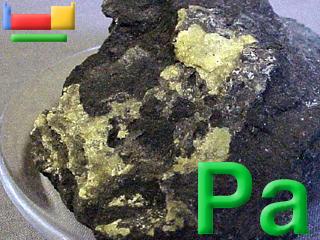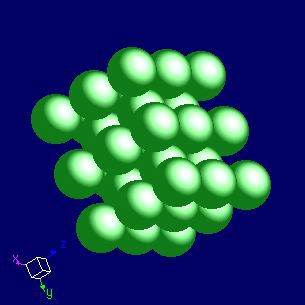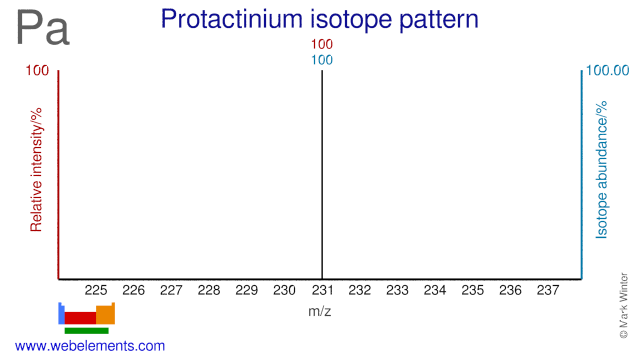Protactinium - 91Pa: the essentials
- Name: protactinium
- Symbol: Pa
- Atomic number: 91
- Relative atomic mass (Ar): 231.03588 (2)
- Standard state: solid at 298 K
- Appearance: silvery metallic
- Classification: Metallic
- Group in periodic table:
- Group name: Actinoid
- Period in periodic table: 7 (actinoid)
- Block in periodic table: f
- Shell structure: 2.8.18.32.20.9.2
- CAS Registry: 7440-13-3
Protactinium atoms have 91 electrons and the shell structure is 2.8.18.32.20.9.2. The ground state electronic configuration of neutral protactinium is [Rn].5f2.6d1.7s2 and the term symbol of protactinium is 4K11/2.
Protactinium: description
Protactinium has a bright metallic lustre which it retains for some time in air. The element is superconductive below 1.4 K. The element is a dangerous toxic material and requires precautions similar to those used when handling plutonium. Protactinium is one of the rarest and most expensive naturally occurring elements. The element is an α-emitter and is a radiological hazard similar to polonium. Protactinium is a highly toxic and radioactive rare earth metal that requires special handling. It is found in pitchblende and ores form Zaire and is one of the rarest and most expensive naturally occurring elements.

This sample of uraninite contains some about 10-6 grammes of actinium at any one time. Image adapted with permission from Prof James Marshall's (U. North Texas, USA) Walking Tour of the elements CD.
Protactinium: physical properties
Density of solid: 15370 kg m-3
Molar volume: 15.18 cm3
Thermal conductivity: 47 (estimate) W m‑1 K‑1
Protactinium: heat properties
Melting point: 1841 [1568 °C (2854 °F)] K
Boiling point: 4300 [ca. 4000 °C (7232 °F)] K
Enthalpy of fusion: 20.5 kJ mol-1
Protactinium: atom sizes
Atomic radius (empirical): 180 pm
Molecular single bond covalent radius: 169 (coordination number 5) ppm
van der Waals radius: [ 340 ] ppm
Protactinium: electronegativities
Pauling electronegativity: 1.5 (Pauling units)
Allred Rochow electronegativity: 1.14 (Pauling units)
Mulliken-Jaffe electronegativity: (no data)
Protactinium: orbital properties
First ionisation energy: 568 kJ mol‑1
Second ionisation energy: 1150 kJ mol‑1
Third ionisation energy: 1790 kJ mol‑1
Protactinium: abundances
Universe: (no data) ppb by weight
Crustal rocks: 0.000010 ppb by weight
Human: (no data) ppb by weight
Protactinium: crystal structure

Protactinium: biological data
Human abundance by weight: (no data) ppb by weight
Protactinium has no biological role.
Protactinium: uses
Protactinium: reactions
Reactions of protactinium as the element with air, water, halogens, acids, and bases where known.
Protactinium: binary compounds
Binary compounds with halogens (known as halides), oxygen (known as oxides), hydrogen (known as hydrides), and other compounds of protactinium where known.
Protactinium: compound properties
Bond strengths; lattice energies of protactinium halides, hydrides, oxides (where known); and reduction potentials where known.
Protactinium: history
Protactinium was discovered by Otto Hahn, Lise Meitner, Frederick Soddy, John Cranston in 1913 at Germany, England. Origin of name: from the Greek word "protos" meaning "first".Protactinium: isotopes

Protactinium: isolation
Isolation: coming soon!
